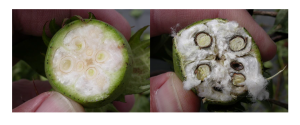by Dr. Josh McGinty – AgriLife Extension Agronomist, Corpus Christi, TX and Dr. Gaylon Morgan – AgriLife Extension State Cotton Specialist, College Station, TX
As this year’s cotton crop is approaching harvest, the proper application of harvest aids is critical to help facilitate an efficient and timely harvest and to preserve fiber quality. Though it is grown as an annual crop, cotton is perennial shrub that will continue to produce new leaves as long as conditions are favorable. Thus, it is important to properly prepare the cotton crop for harvest. As the cotton plant reaches “cut-out” (physiological maturity), the energy demand of the fruit exceeds that produced by the leaves of the plant. At this point, the growth of new leaves is temporarily halted. Once bolls mature and open, however, cotton plants may begin to resume vegetative growth, especially with additional rainfall and excessive soil nitrogen. Any vegetative regrowth before harvest can lead to significant problems due trash in the harvested cotton, lint staining and decreased color in picker-harvested cotton, and high moisture content in modules of stripper-harvested cotton. What follows are a few key points to consider before applying harvest aids.
APPLICATION TIMING
The proper timing of harvest aid applications can be thought of as a balance between allowing immature bolls to mature and preserving the lint quality of earlier maturing bolls. Applying harvest aids too soon may halt the development of green bolls that could contribute to yield, and may negatively affect fiber and seed quality. Outlined below are a few methods for determining the optimal timing for harvest aid applications.
1. Percent Open Boll. This is the most common method outlined on harvest aid product labels. This is simply the percentage of harvestable bolls on the plant that are open. Typically, product labels will recommend applications at 50 to 70% open boll. However, this is not the most accurate method as research has shown that optimal application timings may range from 42 to 81% open boll, depending on distribution of fruit on the plant.
2. Sharp Knife Technique. A determination of boll maturity can be made by cutting a cross section of the uppermost harvestable boll. A mature boll will be difficult to cut and will contain seed with dark seed coats and fully developed cotyledons. Very light colored seed coats and the presence of “jelly” inside the seed indicate an immature boll. See pictures below.
3. Nodes above Cracked Boll (NACB). From the uppermost first position cracked boll, count the main stem nodes from there up to the uppermost harvestable boll. Sufficient research has shown that harvest aids applied at three NACB will not result in any lint weight loss. If harvest aids are applied at NACB greater than four, yield loss can be expected.
The efficacy of harvest aid products is greatly affected by environmental conditions. In general, the most effective harvest aid applications are made under warm, sunny conditions, with low soil moisture (but sufficient to maintain active growth), without excessive soil nitrogen, to plants that have reached maturity and are not producing new leaves. Thorough spray coverage is critical when applying harvest aids. Choose a spray nozzle that will provide uniform coverage and small spray droplets. Total spray volume should be at least 15 GPA for ground applications and 5 GPA when aerially applied.
HARVEST AID PRODUCT TYPES
Cotton harvest aid chemicals are generally grouped into three categories – defoliants, desiccants, and boll openers. The most effective product or combination of products varies depending on the type of cotton (picker- vs stripper-type), the harvest method, and environmental conditions.
Defoliants remove foliage from the cotton plant by stimulating ethylene production, which promotes the formation of an abscission layer at the base of leaf petioles. Defoliants can be classed into two categories: (1) hormonal defoliants such as thiadiazuron (Dropp, FreeFall, etc.), and (2) herbicidal defoliants such as tribufos (Folex) and the PPO inhibitors (Aim, Display, Sharpen, etc.). For conventional cotton (non-Roundup Ready), glyphosate may be used as an herbicidal defoliant. If applied at too high a rate, herbicidal defoliants may cause excessive leaf injury, preventing the formation of the abscission layer and resulting in “stuck” leaves.
Desiccants, such as paraquat or sodium chlorate, simply kill and dry plant tissues. At the higher rates, these products act very rapidly and do not allow an abscission layer to form at the junction of leaf petioles and the stem, resulting in “stuck” leaves. Desiccants are typically used in stripper-harvested cotton to dry plant tissues after a defoliant has been applied. Desiccants can be used at lower rates to help defoliate cotton, but selecting the appropriate rate to defoliate and not desiccate is challenging and is dependent upon environmental conditions.
Boll openers contain the active ingredient ethephon. Within the plant, ethephon is converted to ethylene, which causes bolls to open at a more rapid pace. Increased levels of ethylene within the plant also help activate abscission layers of the leaf petioles, further defoliating the plant. It is important to note that although ethephon does hasten the opening of bolls, it will not speed up the maturity of immature bolls. Additionally, boll openers tend to enhance basal and terminal leaf growth following the application, thus timely harvest is more critical when using a boll opener.
For more information, consult local AgriLife Extension professionals and these helpful publications:
High Plains and Northern Rolling Plains Cotton Harvest-Aid Guide
http://lubbock.tamu.edu/files/2014/09/2014_Harvest_Aid_Guide.pdf
Cotton Harvest Aid Guidelines for Louisiana
http://www.lsuagcenter.com/NR/rdonlyres/4D483B1B-EE9E-40ED-ACA2-7ECA29525D61/98884/pub3194CottonHarvestAidGuidelines2014.pdf
 Immature cotton boll (left) that needs additional time to mature indicated by the lightly colored seed coats and jelly-like interior of seeds. Mature boll (right) with developed seed coat and cotyledons.
Immature cotton boll (left) that needs additional time to mature indicated by the lightly colored seed coats and jelly-like interior of seeds. Mature boll (right) with developed seed coat and cotyledons.

Josh McGinty
Assistant Professor & Extension Agronomist
Corpus Christi, TX
jmcginty@tamu.edu